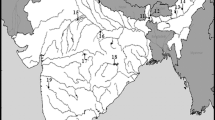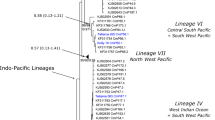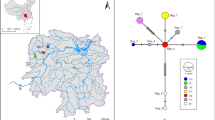Abstract
Asian box turtles (genus Cuora, family Geoemydidae) comprise a clade of 12 aquatic and semiaquatic nominate species distributed across southern China and Southeast Asia. Over the last two decades, turtles throughout Asia have been harvested at an unsustainable rate to satisfy demands for food, traditional Chinese medicine, and the pet trade. Consequently, all species of Cuora were recently placed on the IUCN Red List, nine are currently listed as critically endangered by the IUCN, and all species are listed in Appendix II of CITES. We compiled a 67-specimen mitochondrial (∼1,650 base pairs (bp) from two mitochondrial genes) and a 40-specimen nuclear-plus-mitochondrial (∼3,900 bp total, three nuclear introns plus an additional ∼860 bp mitochondrial gene fragment) DNA data set to reconstruct the phylogeny of Cuora species and to assess genetic diversity and species boundaries for several of the most problematic taxa. Our sampling included 23 C. trifasciata, 17 C. zhoui and 1–4 individuals of the remaining 10 species of Cuora. Maximum likelihood, maximum parsimony and Bayesian analyses all recovered similar, well resolved trees. Within the Cuora clade, mitochondrial and nuclear sequence data indicated that both C. zhoui and C. mccordi represent old lineages with little or no history of interspecific gene flow, suggesting that they are good genealogical species. Based on mtDNA, Cuora pani was paraphyletic and C. trifasciata was composed of two highly divergent lineages that were not each other’s closest relatives; both cases of non-monophyly were due to a mtDNA sequence that was widespread and identical in C. aurocapitata, C. pani and C. trifasciata. However, when combined with nuclear DNA results, our data indicate that C. trifasciata is a single, monophyletic taxon, and that mitochondrial introgression and nuclear-mitochondrial pseudogenes have led to a complex pattern of mitochondrial gene relationships that does not reflect species-level histories. Our results imply that captive “assurance colonies” of both C. trifasciata and C. pani should be genotyped to identify pure, non-hybrid members of both taxa, and we recommend that introgressed and pure taxa be managed as independent entities until the full evolutionary histories of these critically endangered turtles are resolved.





Similar content being viewed by others
References
Artner H, Becker H, Jost, U (1998) Erstbericht über Haltung und Nachzucht der Japanischen Sumpfschildkröte Mauremys japonica (Temminck and Schlegel, 1835). Emys 5:5–22
Bates JM, Bowie RCK, Willard DE et al (2004) A need for continued collecting of avian voucher specimens in Africa: why blood is not enough. Ostrich 74:187–191
Bhangale TR, Rieder MJ, Livingston RJ, Nickerson DA (2005) Comprehensive identification and characterization of diallelic insertion-deletion polymorphisms in 330 human candidate genes. Hum Mol Gen 14:59–69
Brandley MC, Schmitz A, Reeder TW (2005) Partitioned Bayesian analyses, partition choice, and the phylogenetic relationships of scincid lizards. Syst Biol 54:373–390
Casula M, Bosboom-Dobbelaer I, Smolders K et al (2005) Infection with HIV-1 induces a decrease in mtDNA J. Infect Dis 191:1468–1471
van Dijk PP (2000) The status of turtles in Asia. In: van Dijk PP, Stuart S, Rhodin A (eds) Asian turtle trade proceedings of a workshop on conservation and trade of freshwater turtles and tortoises in Asia. Phnom Penh, Cambodia, December 1999. Chelonian Research Monographs 2. Chelonian Research Foundation. Lunenberg, pp 39–44
van Dijk PP, Stuart BL, Rhodin AGJ (eds) (2000) Asian turtle trade proceedings of a workshop on conservation and trade of freshwater turtles and tortoises in Asia Phnom Penh, Cambodia, 1–4 December 1999. Chelonian Research Monographs 2. Chelonian Research Foundation, Lunenberg
Engstrom TN, Shaffer HB, McCord WP (2004) Multiple data sets, high homoplasy, and the phylogeny of softshell turtles (Testudines: Trioinychidae). Syst Biol 53:693–710
Ernst CH, Barbour RW (1989) Turtles of the world. Smithsonian Institution Press, Washington
Feldman CR, Parham JF (2004) Molecular systematics of Old World stripe-necked turtles (Testudines: Mauremys). Asiat Herpetol Res 10:28–37
Felsenstein J (1985) Confidence limits on phylogenies: an approach using the bootstrap. Evolution 39:783–791
Fritz U, Obst FJ (1997). Zum taxonomischen Status von Cuora galbinifrons serrata Iverson and McCord, 1992 und Pyxidea mouhotii (Gray, 1862) (Reptilia: Testudines: Bataguridae). Zool Abh Staatl Mus Tierk Dresden 49:261–279
Fujita MF, Engstrom TN, Starkey DE, Shaffer HB (2004) Turtle phylogeny: insights from a novel nuclear intron. Mol Phylogenet Evol 31:1031–1040
Gahan ME, Miller F, Lewin SR, Cherry CL et al (2001) Quantification of mitochondrial DNA in peripheral blood mononuclear cells and subcutaneous fat using real-time polymerase chain reaction. J Clin Virol 22:241–247
Hazkani-Covo E, Sorek R, Graur D (2003) Evolutionary dynamics of large numts in the human genome: rarity of independent insertions and abundance of post-insertion duplications. J Mol Evol 56:169–174
Honda M, Yasukawa Y, Hirayama R, Ota H (2002a) Phylogenetic relationships of the Asian box turtles of the genus Cuora sensu lato (Reptilia: Bataguridae) inferred from mitochondrial DNA sequences. Zool Sci 17:1305–1312
Honda M, Yasukawa Y, Ota H (2002b) Phylogeny of the Eurasian freshwater turtles of the genus Mauremys Gray 1869 (Testudines) with special reference to a close affinity of Mauremys japonica with Chinemys reevesii. J Zool Syst Evol Res 40:195–200
Horlein AK, Grajer H, Igo-Kemenes T (1993) Genomic structure of the POU-related hepatic transcription factor HNF-1 alpha. Biol Chem Hoppe-Seyler 374:419–425
Hudson RR, Coyne JA (2002) Mathematical consequences of the genealogical species concept. Evolution 56:1557–1565
Huelsenbeck JP, Ronquist F (2001) MRBAYES: Bayesian inference of phylogeny. Bioinformatics 17:754–755
IUCN (2006) 2006 IUCN red list of threatened species. http://www.iucnredlist.org. Downloaded on 25 June 2006
Iverson JB (1992) A revised checklist with distribution maps of the turtles of the world. Privately printed. Richmond, IN
Kou Z (1989) Cyclemys from Yunnan, a description of a new species and a new record to China (Testudinata: Emydidae) In: Current Herpetology in East Asia, Kyoto, pp 193–197
Lau M, Haitao S (2000) Conservation and trade of terrestrial and freshwater turtles and tortoises in the People’s Republic of China. In: van Dijk P, Stuart S, Rhodin A (eds) Asian turtle trade proceedings of a workshop on conservation and trade of freshwater turtles and tortoises in Asia. Phnom Penh, Cambodia, December 1999. Chelonian Research Monographs 2. Chelonian Research Foundation, Lunenberg, pp 30–38
Lau M, Chan B, Crow P, Ades G (2000) Trade and conservation of turtles and tortoises in the Hong Kong Special Administrative Region, People’s Republic of China. In: van Dijk P, Stuart S, Rhodin A (eds) Asian turtle trade proceedings of a workshop on conservation and trade of freshwater turtles and tortoises in Asia. Phnom Penh, Cambodia, December 1999. Chelonian Research Monographs 2. Chelonian Research Foundation, Lunenberg, pp 39–44
Luo B, Zong Y (1988). A new species of Cuora–Cuora aurocapitata. Acta Herpetologica Sinica 3:13–15
Maddison DR, Maddison WP (2003) MacClade 4: analysis of phylogeny and character evolution, version 4.06. Sinauer, Sunderland
McCord WP, Iverson JB (1991) A new box turtle of the genus Cuora (Testudines: Emydidae) with taxonomic notes and a key to the species. Herpetologica 47:407–420
Near TJ, Meylan PA, Shaffer HB (2005) Assessing concordance of fossil calibration points in molecular clock studies: an example using turtles. Am Nat 165:137–146
Parham JF, Li D (1999) A new locality for Cuora pani song 1984 with comments on its known range. Asiat Herpetol Res 8:111–113
Parham JF, Simison BW, Kozak KH et al (2001) New Chinese turtles: endangered or invalid? A reassessment of two species using mitochondrial DNA, allozyme electrophoresis and known-locality specimens. Anim Conserv 4:357–367
Parham JF, Stuart BL, Bour R, Fritz U (2004) Evolutionary distinctiveness of the extinct Yunnan box turtle (Cuora yunnanensis) revealed by DNA from an old museum specimen. Proc R Soc Lond B 271:S391–S394
Parham JF, Feldman CR, Boore JR (2006) The complete mitochondrial genome of the enigmatic bigheaded turtle (Platysternon): description of unusual genomic features and the reconciliation of phylogenetic hypotheses based on mitochondrial and nuclear DNA. BMC Evol Biol 6:11. DOI:10.1186/1471–2148–6-11
Pereira SL, Baker AJ (2004) Low number of mitochondrial pseudogenes in the chicken (Gallus gallus) nuclear genome: implications for molecular inference of population history and phylogenetics. BMC Evol Biol 4:17
Posada D, Crandall KA (1998) Modeltest: testing the model of DNA substitution. Bioinformatics 14:817–818
Primmer CR, Borge T, Lindell J, Sætre GP (2002) Single-nucleotide polymorphism characterization in species with limited available sequence information: high nucleotide diversity revealed in the avian genome. Mol Ecol 11:603–612
Robin ED, Wong R (1988) Mitochondrial DNA molecules and virtual number of mitochondria per cell in mammalian cells. J Cell Physiol 136:507–513
Ronquist F, Huelsenbeck JP (2003) MRBAYES 3: Bayesian phylogenetic inference under mixed models. Bioinformatics 19:1572–1574
Royaux I, de Rouvroit CL, D’Arcangelo G et al (1997) Genomic organization of the mouse Reelin gene. Genomics 46:240–250
Sambrook J, Russell DW (2001) Molecular cloning: a laboratory manual, 3rd edn. Cold Spring Harbor Laboratory Press, Cold Spring Harbor
Shi H, Parham JF, Simison WB et al (2005) A report on the hybridization between two species of threatened Asian box turtles (Testudines: Cuora) in the wild on Hainan Island (China) with comments on the origin of ‘serrata’-like turtles. Amphibia-Reptilia 26:377–381
Song M (2001) Translation: a new species of the turtle genus Cuora (Testudoformes: Testudinidae). Asiat Herpetol Res 9:142–144
Sorenson MD, Quinn TW (1998) Numts: a challenge for avian systematics and population biology. Auk 115:214–221
Spinks PQ, Shaffer HB (2005) Rangewide molecular analysis of the western pond turtle (Emys marmorata): cryptic variation, isolation by distance, and their conservation implications. Mol Ecol 14:2047–2064
Spinks PQ, Shaffer HB, Iverson JB, McCord WP (2004) Phylogenetic hypotheses for the turtle family Geoemydidae. Mol Phylogenet Evol 32:164–182
Starkey DE, Shaffer HB, Burke RR et al (2003) Molecular systematics, phylogeography, and the effects of Pleistocene glaciation in the painted turtle (Chrysemys picta) complex. Evolution 57:119–128
Stuart BL, Parham JF (2006) Recent hybrid origin of three rare Chinese turtles. Conserv Genet (in press)
Stuart BL, Parham JF (2004) Molecular phylogeny of the critically endangered Indochinese box turtle (Cuora galbinifrons). Mol Phylogenet Evol 31:164–177
Stuart BL, van Dijk PP, Hendrie DB (2001) Photographic guide to the turtles of Thailand, Laos, Vietnam and Cambodia. Wildlife Conservation Society, Phnom Penh
Swofford DL (2002) PAUP*. Phylogenetic analysis using parsimony (*and other methods). Version 4. Sinauer Associates, Sunderland
Thalman O, Hebler J, Poinar HN et al (2004) Unreliable mtDNA due to nuclear insertions: a cautionary tale from analysis of humans and other great apes. Mol Ecol 13:321–335
UNEP-WCMC. 6 October, 2005. UNEP-WCMC Species Database: CITES Listed Species on the World Wide Web. http://www.sea.unep-wcmc.org
Wink M, Guiking D, Fritz U (2001) Molecular evidence for hybrid origins of Mauremys iversoni Pritchard and McCord, 1991, and Mauremys pritchardi McCord, 1997 (Reptilia: Testudines: Bataguridae). Zool Abh Staatl Mus Tierk Dresden 52:41–49
Wood FE, Ebanks GK (1984) Blood cytology and hematology of the green sea turtle, Chelonia mydas. Herpetologica 40:331–336
Yang Z (1996) Maximum-likelihood models for combined analysis of multiple sequence data. J Mol Evol 42:587–596
Acknowledgments
Harald Artner, Elmar Meier, and Hans-Dieter Philippen are thanked for much assistance to PQS and for facilitating sample collections. For tissue samples, we thank H. Artner, James Barzyk, Rafe Brown (University of Kansas Natural History Museum), Carla Cicero (Museum of Vertebrate Zoology), Gary Ades and Paul Crow (Kadoorie Farms and Botanical Gardens), Rick Hudson (Fort Worth Zoo), Elmar Meier, and Alan Resetar (Field Museum of Natural History). Jim Parham, Dave Starkey, Bryan Stuart, and an anonymous reviewer provided helpful comments on the manuscript. This material is based upon work supported by the National Science Foundation under grants No. DEB-0213155, DEB-0516475 and DEB-0507916, and the UC Davis Agricultural Experiment Station.
Author information
Authors and Affiliations
Corresponding author
Appendix
Appendix
Rights and permissions
About this article
Cite this article
Spinks, P.Q., Shaffer, H.B. Conservation phylogenetics of the Asian box turtles (Geoemydidae, Cuora): mitochondrial introgression, numts, and inferences from multiple nuclear loci. Conserv Genet 8, 641–657 (2007). https://doi.org/10.1007/s10592-006-9210-1
Received:
Accepted:
Published:
Issue Date:
DOI: https://doi.org/10.1007/s10592-006-9210-1




